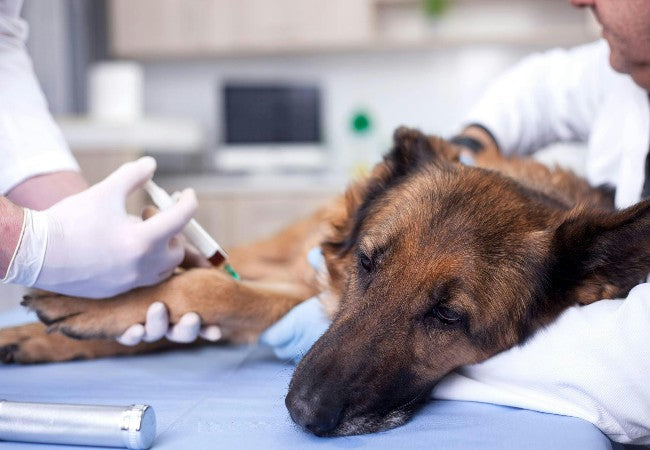Vet’s 2025 Guide to Canine Encephalitozoonosis Tiny Parasite, Big Impact 🩺

In this article
Vet’s 2025 Guide to Canine Encephalitozoonosis: Tiny Parasite, Big Impact 🩺
By Dr. Duncan Houston BVSc
💡 Introduction
Encephalitozoonosis—caused by the microsporidian parasite Encephalitozoon cuniculi—is rare in dogs but can cause serious neurological or renal illness, especially in puppies or immunocompromised pets. In 2025, vets use advanced diagnostics, effective antiparasitic therapy, and supportive care to manage this condition. This comprehensive guide covers causes, signs, diagnosis, treatment, prevention, zoonosis risk, and how Ask A Vet supports you throughout your dog’s journey. 🐶❤️
1. What Is Encephalitozoonosis?
Encephalitozoonosis is a parasitic disease resulting from infection by E. cuniculi, a spore-forming organism closely related to fungi . It primarily affects the kidneys and brain, but may also involve the eyes, liver, and lungs . While rabbits are its most common host, dogs can be infected—especially with strain III (canine strain) .
2. Transmission & Risk Factors
- Oronasal exposure: Dogs ingest or inhale spores shed in urine or feces of infected animals (e.g., rabbits, rodents) .
- In utero transmission: Affected in puppies—can cause miscarriage or fatal neonatal disease .
- Immunocompromise: Puppies, sick or immunosuppressed dogs, are most vulnerable .
- Geographic range: Worldwide—spores can survive months in the environment .
3. Who Can Be Affected?
While all breeds and ages can be infected, most documented cases involve:
- Puppies, often with neurological or renal failure .
- Dogs in contact with infected rabbits/rodents or in kennel situations .
- Immunosuppressed adults, due to illness or medication .
4. Clinical Signs in Dogs 🩺
Symptoms vary by organ involvement and can be subtle or severe.
4.1 Neurologic Signs
- Depression, anorexia
- Head tilt, circling, ataxia, tremors, tremulousness .
- Seizures or paresis in advanced cases .
4.2 Renal Signs
- Polyuria/polydipsia
- Lethargy, weight loss
- Azotemia in bloodwork; kidney lesions seen in necropsy .
4.3 Ocular Signs
- Cataracts, phacoclastic uveitis—common in ocular cases .
5. Diagnosing in 2025 📋
5.1 Clinicopathologic & Imaging
- CBC/chemistry may show kidney dysfunction or anemia; urine tests may indicate proteinuria.
- MRI/CT for neurologic signs if available; helps rule out other brain causes .
5.2 Serology & PCR
- Serology (IgM/IgG titers): suggests exposure; rising IgM indicates recent infection .
- PCR on blood, urine, or CSF increases diagnostic confirmation .
5.3 Eye-Specific Tests
In ocular cases, lens aspirate PCR or phacoemulsification with lab testing may certify E. cuniculi uveitis .
5.4 Definitive Diagnosis
Histopathology of brain/renal tissue post-mortem remains the gold standard .
6. Treatment & Supportive Care 🛡️
6.1 Antiparasitic Therapy
- Fenbendazole: 25–55 mg/kg daily for 10–30 days—effective, safer than albendazole .
- Albendazole: Alternate option, but riskier—use strict dosing .
6.2 Anti-inflammatory Therapy
NSAIDs or corticosteroids used for severe inflammation or ocular involvement, but caution in renal cases .
6.3 Supportive Care
- IV fluids and electrolyte support for kidney injury
- Nutritional support, appetite stimulants
- Seizure control if needed
- Ophthalmologic care for lens inflammation or uveitis
6.4 Prognosis
- Puppies: prognosis is often poor if severe CNS/renal involvement—fatal in many cases .
- Adults: good recovery possible with prompt fenbendazole and support, though ≈50% may retain mild neurologic deficits .
- Ocular cases: early lens removal + antiparasitic therapy improves outcomes significantly .
7. Home Handling & Ask A Vet Support
- Log drinking, urination, appetite, neurologic signs—use app for tracking and photo/video uploads
- Medication reminders for fenbendazole dosing
- Guidance on hydration, feeding, seizure response, eye drop schedules
- Alerts for signs needing immediate re-evaluation (e.g., worsening tremors, collapse)
8. Prevention & Zoonotic Considerations 🌍
- Hygiene: clean bedding promptly, disinfect areas with bleach/hyperchlorite, especially in multi-pet/hospital settings.
- Avoid co-housing with rabbits or rodents
- Monitor pregnant dogs with exposure risk—early testing advised
- Zoonosis: Rare in healthy owners; immunocompromised people (HIV, transplant) are at risk—wear gloves, practice hygiene when handling sick animals .
9. 2025 Research Highlights
- Fenbendazole improves outcomes vs older regimens .
- Strain III (canine strain) is better recognized—helps in tailoring diagnostics .
- Integrated eye-surgery + antiparasitic therapy increases success in ocular cases .
- Veterinary/public health agencies discussing routine screening in rehabilitation and hospital settings .
🔍 Key Takeaways
- Canine encephalitozoonosis is rare but potentially serious, affecting nervous and urinary systems.
- Diagnosis relies on serology, PCR, imaging, and occasionally histopathology.
- Treated in 2025 primarily with fenbendazole combined with support; early ocular treatment may involve surgery.
- Puppies often have worse outcomes; adults may recover with supportive care.
- Ask A Vet helps track symptoms, medications, seizure management, and hygiene between vet visits.
Conclusion ❤️
Though canine encephalitozoonosis might sound alarming, modern diagnostics and treatment offer real hope, especially with early recognition and supportive care. In 2025, vets and pet owners are better equipped than ever to manage and monitor this rare but impactful disease. With Ask A Vet guiding your home care routine, your dog can navigate recovery with confidence and comfort. 🐕✨
Dr Duncan Houston BVSc – blending compassionate veterinary science and pet parent support.
Discover more at AskAVet.com and download the Ask A Vet app for 24/7 support, medication reminders, and symptom tracking during your pet’s recovery journey. ❤️






